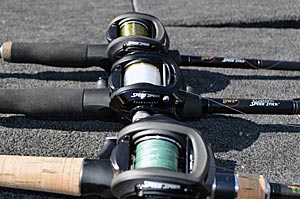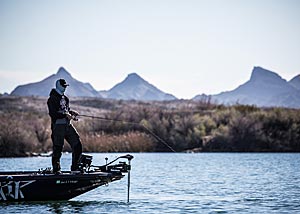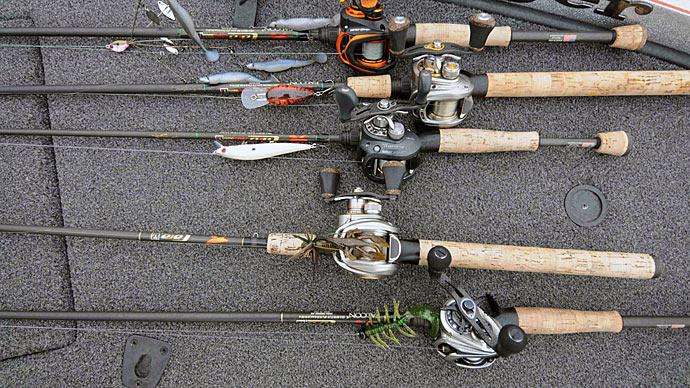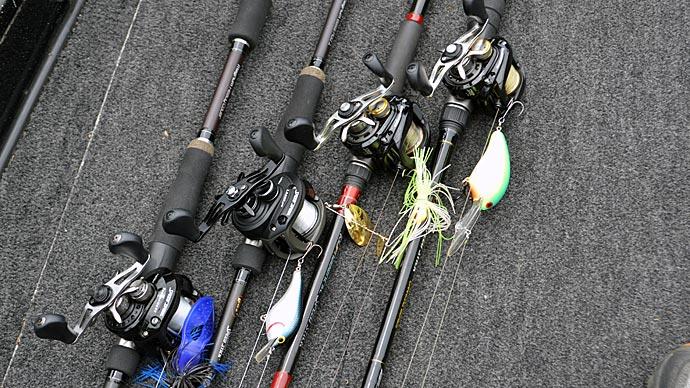
Falcon Lake straddles the U.S.-Mexico border near Zapata, Texas, and has a reputation for big bass. This is where tournament legend Paul Elias caught 132 pounds and 8 ounces of bass over four days to win a 2008 Bassmaster Elite Series tournament. But fishing isn’t easy. The lake is filled with standing timber, rock piles, and hydrilla. Rugged gear is a must.
The Rio Grande River reservoir was Josh Bertrand's rookie season's second 2013 Bassmaster Elite Series stop. He arrived with reels filled with heavy-duty super line and 20-pound test fluorocarbon leaders. At least at first, he used the combination to drag Carolina rigs around deep timber. “When an 8-pounder wraps 20-pound test in a tree, it doesn’t matter what you have. It’s gone,” he said. So he switched to 25-pound test fluorocarbon leaders. “It helped me a lot,” he said. “I didn’t lose another fish that tournament.” When the scales closed, the Arizona angler had 99 pounds and 2 ounces, which was enough weight for fourth place.
Bertrand invests a lot of time matching lines to the fishing conditions he encounters across the country. “Having the right line is important,” he said. Choosing the correct line is not only for feeling bites and landing bass. “Line affects how your bait is presented.” He classifies line into three main types: monofilament, fluorocarbon, and super lines, also called braid. He uses them all, from 6- to 65-pound test. It can be difficult to match the right one to current conditions when there is an endless variety of sizes and colors to choose from. But you can cut through the confusion and put more bass in your boat if you follow the fourth-year Elite Series angler’s guidance.
Monofilament
Anglers used lines spun from Dacron, cotton, and other natural fibers until the late 1950s. That’s when DuPont introduced the first nylon monofilament fishing line branded with the name Stren. Other manufacturers introduced their versions soon after, and monofilament became the clear choice for bass anglers for several decades. While monofilament’s stretch and lack of abrasion resistance, compared to other line materials, has caused its popularity to wane, Bertrand still uses it in two critical situations.
The first is fishing topwater baits in clear water with sparse cover. Monofilament floats. This characteristic lets topwater lures work to their full potential. The second situation is fishing jerkbaits in frigid water. He lets the lure sit motionless for as long as 30 seconds to entice strikes from sluggish bass. That’s easier to accomplish with monofilament, which floats and won’t unnaturally pull the lure.
It’s a pattern that may play a role in the 2016 Bassmaster Classic when he and the other qualifiers fish Oklahoma’s Grand Lake in March.
Picking the pound test of the line depends on several factors. For that jerkbait bite, you might need as light as 8–pound test in clear water, though 12-pound test will work in stained water. Your line should get heavier as your lures become bigger, the water dirtier, and the cover heavier. That goes for all three types. If you’re using finesse worms in clear water, for example, reach for 6- or 8-pound test. If you’re flipping big jigs to laydowns in muddy river water, use as strong as you want, as long as it isn’t so heavy that it deadens the lure’s action.
Fluorocarbon
Outside of when Bertrand reaches for monofilament, his fishing is almost evenly split between fluorocarbon and super lines. And of those two, he’ll most likely use fluorocarbon exclusively during the upcoming Classic, when he’ll fish moving and bottom-bouncing lures around structure and light cover.
Fluorocarbon is tough. It stands up to abrasions that would compromise monofilament. It sinks, driving crankbaits deeper. It stretches less than monofilament, letting you feel more and surely set hooks. But it’s more forgiving than super lines, and that stretch is essential when you have a bass hanging by a tiny treble hook on a crankbait. “You might as well kiss that fish goodbye,” Bertrand said if you’re using a super line.
Super line
If super lines aren’t for fishing small crankbaits, when does Bertrand use them? You’ll find the answer at the first stop of the 2016 Bassmaster Elite Series. “At the St. John’s, it’ll probably all be braid — big baits, flipping, frogging,” he said.

Super lines have zero stretch, aren’t phased by abrasions, and are the most sensitive. This line is a fraction of the diameter of similar pound-test monofilaments and fluorocarbons. That makes this line perfect for fishing under heavy cover, such as the thick grasses that fill most of this Florida tidal river.
Sometimes in clear water, Bertrand adds a 3- to 4-foot long leader of Trilene 100% Fluorocarbon to hide his super line from wary bass. If he’s casting 50-pound test super line, he’ll tie on a 17-pound test leader. He joins the two with an Alberto knot, which wraps the main line around and through a loop in the leader. Its tag ends run more parallel to the line than with the double-uni, another popular line-to-line knot. That means it quickly goes through your rod’s line guides, especially semi-micros. He also feels it resists impact better, which is essential when using no-stretch super lines.
Bertrand uses the same knot to attach fluorocarbon leaders — from 6- to 10-pound test — to the 8-pound test Berkley NanoFil that he uses on his spinning reels. Leaders are easy to change, allowing him to try different pound tests pulled from small spools he carries in the boat while perfecting a presentation.
A short leader — a foot or two long — is easier to cast because the knot travels through fewer rod guides. When fishing vertical, use one long enough to keep your lure in front of the fish. If you want to fish a drop shot for bass suspended four feet above the bottom, use at least a 6-foot leader. That will keep your super line a safe distance from your lure. Longer leaders also save time. A few extra feet means you can retie your lure a couple of times without having to replace the entire leader.
Using the traditional “cross his eyes” hookset with no-stretch super lines puts much stress on the leader. Medium-action spinning rods, which have a more parabolic bend and softer hook sets, help Bertrand protect knots and not tear hooks from bass. He makes a similar move with his casting rods.
Line colors
Once you’ve selected a line type, you’ll need to choose its color. You can’t go wrong with clear fluorocarbon. Its refractive index is nearly the same as water. That means light passes through them almost identically, making the line close to invisible when submerged.
The choices are more numerous for monofilaments. The popular options are clear, green, and camouflage — alternating natural hues.
Bertrand uses two colors of super line. Low-visibility green is loaded on his casting reels, even when using a leader. That’s because the line passes through the strike zone before the lure, and he doesn’t want a bright color tipping off bass. He uses spinning rods primarily for vertical presentations such as drop shotting. He loads those with a high-visibility super line, such as white NanoFil, and a fluorocarbon leader. Since he is fishing vertically, bass only see the leader, and the high-visibility super line lets him see subtle bites.
Line maintenance
The line does not last forever. Use, environmental conditions, and fishing style all take a toll. But how quickly the tolls add up depends on the type of line.
Bertrand frequently changes fluorocarbon and monofilament during the tournament season and sometimes daily. He usually changes fluorocarbon leaders several times each day. During the offseason, he might fish the entire fall and winter with a spool of fluorocarbon. Monofilament is changed after several trips when memory and its lack of abrasion resistance affect its performance. He knows to replace fluorocarbon when it turns a milky hue and feels rough. Super lines last longest because their base materials are impervious to abrasion and weather. By the time he is ready to change it out, he estimates he would have used ten spools of fluorocarbon.
Many super lines lose their color as they age. NanoFil, for example, flattens out with use. “That doesn’t affect its strength or how it fishes,” Bertrand said. High temperatures, such as those found inside a vehicle or covered boat, can affect the strength of monofilament and fluorocarbon. “I’m guilty of leaving it in the hot garage through summer,” he said. “I haven’t experienced any issues from doing it.” However, to ensure a longer life, keeping them in a cool, dark place is better.
Spooling up
Preparation is essential when spooling reels with line. Bertrand recommends backing if your reel doesn’t come with a shallow spool. You’ll never fish with an entire reel spool of line, so adding backing, which can be the old line of any pound test, saves time and money when re-spooling. Take spinning reels, for example. If he filled each with 8-pound test Nanofil, he would empty an entire 300-yard filler spool for each and still only use the top third. He fills reels about a quarter way with backing, leaving the remaining room for new line.
Use a line-to-line knot to attach new line to the backing. If your rod has micro guides, tie it between the bottom guide and the reel because it won’t fit through the guides. Push the knot to one side with your finger when it goes on the spool. That will save problems later. The knot will reappear when break-offs and retying have used a good portion of the new line. It’s more likely to grab the line and stop casts short if near the center of the spool.
Backing solves a problem inherent to super lines. When tied to a metal spoon, it often slips, allowing the spool to turn independently of the line. Adding a little electrical tape or monofilament on the spool first gives the super line something to grab. Some spinning reels are sold with an alternate shallow spool that sports a rubber insert, which solves that problem, too.
Bertrand winds line, regardless of type, from the top of filler spools to his baitcasters. He’ll use a pencil through the center or the original box to hold the spool. If you don’t have a helper to hold the filler spool, take a box or two out of your tackle bag, and use that to hold it. You also can purchase line boxes and gadgets that fasten to a flat surface with suction cups. They hold filler spools under tension, keeping them from backlashing.
For spinning reels, lay the filler spool flat on the floor. Crank on about 10 yards, and then drop the rod tip. If the slack line coils, flip the filler spool over. If not, keep winding. That puts line on the reel the same way it comes off the spool, reducing twists and wind knots.
Smoothly and tightly spooled line casts better and tangles less. Hold the rod above the reel with one hand, drawing the new line through pinched fingers. Sometimes casting reels spool line unevenly. Winding it on slowly helps with that problem, and any slight variations across the spool usually sort themselves out within a few casts.




